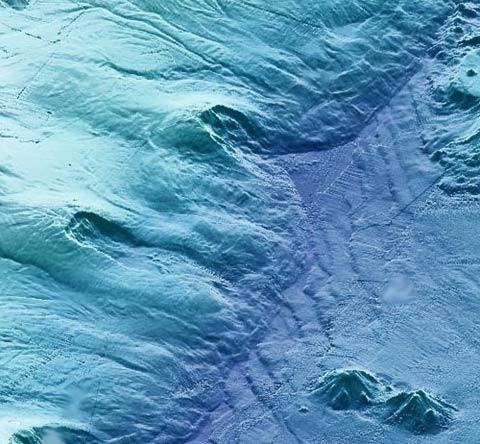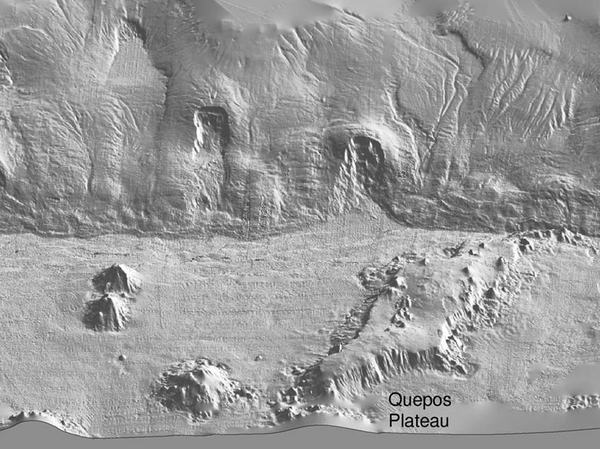
Diving Mountains: Can They Stop, or Start, Earthquakes?

What happens when inexorable geological forces shove a giant seafloor mountain beneath a continent? This is not the improbable premise of a bad eco-disaster movie, but a serious area of inquiry — and a question with few clear-cut answers, scientists say.
However, new technology is allowing researchers improved glimpses of what happens when a seafloor mountain crashes into and under a continental plate, and what role the slow-motion collision plays in earthquakes.
These collisions occur out of sight, along subduction zones, where oceanic plates subduct, or dive under, overlying continental plates. As the oceanic plate goes, so goes the mountain that sits atop it, slowly burrowing into the side of the continental plate, and then deeper and deeper beneath it.
Tunneling mountains
Yet these subduction zones aren't always slow movers. When the oceanic plate suddenly slips, it generates an earthquake — sometimes a massive one, such as last year's devastating Tohoku earthquake in Japan.
Some research has cast seafloor mountains (called seamounts) as heroes, suggesting the peaks are capable of halting a subduction earthquake in its tracks.
"To get a super-big quake you need to break a large portion of the plate boundary in one shot, and subducting seamounts may segment the plane in big earthquakes — so it doesn't all go at once," said Anne Trehu, a geophysicist at Oregon State University.
Sign up for the Live Science daily newsletter now
Get the world’s most fascinating discoveries delivered straight to your inbox.
Yet new research suggests these burrowing mountains can also play the villain.
"They could form a barrier to a giant earthquake — and they could also easily trigger a giant earthquake," said Roland von Huene, a veteran geophysicist who has studied subducting seamounts for more than 30 years.

Good mountain, bad mountain
New research has tied a spate of earthquakes in Oregon to a tunneling seamount scientists estimate is about 16,000 feet (5,000 meters) high — taller than the Alps.
Dubbed M2, the buried seamount lies about 19 miles (30 kilometers) off the Oregon coastline. Over millennia, the mountain has tunneled about 28 miles (45 km) eastward into the North American plate, and is buried beneath about 7 miles (12 km) of rock. [Infographic: Tallest Mountain to Deepest Ocean Trench]
The mountain is likely behind a magnitude 4.8 earthquake in 2004, which was felt on land, along with a series of smaller quakes. So why is it acting up now?
It's likely because the mountain is now facing much harder rocks in the overlying continental plate than it has yet encountered, said Trehu, who led research on the quakes published in the Dec. 16 issue of the journal Geology.
"You have seismicity concentrated there because you have a seamount hitting up against crystalline rocks," Trehu said — which are far harder than the sedimentary rocks the mountain plowed through on the first leg of its subterranean journey.
However, Trehu cautioned, that is simply an interpretation of compelling data, and the idea is controversial. "Some people argue it's just chance that you have earthquakes there now," she said.
Nearby menace
The Cascadia subduction zone, where the seamount is subducting, stretches from Vancouver to northern California, and has produced colossal earthquakes in the past. In 1700, the subduction zone unleashed a powerful earthquake, likely a magnitude 9.0, which sent a damaging tsunami ashore in Japan.
And although the Cascadia hasn't produced a massive earthquake in more than 300 years, it will undoubtedly do so again. There's just no telling when or why, Trehu said.
It's not at all clear what relationship the small earthquakes likely produced by the burrowing seamounts would have to a massive, dangerous quake, Trehu said.
However, she said, technology that allows for better imaging of the buried mountains, and the reams of data gathered on the devastating subduction quakes that struck in Chile in 2010 and in Japan in 2011 are helping scientists develop better theories about what role seafloor topography plays in earthquakes.
"We're looking for causative relationships between structure and slip," she said. "So we're using the lessons from Japan and Chile to better anticipate what could happen here."
This story was provided by OurAmazingPlanet, a sister site to LiveScience. Reach Andrea Mustain at amustain@techmedianetwork.com. Follow her on Twitter @AndreaMustain.Follow OurAmazingPlanet for the latest in Earth science and exploration news on Twitter @OAPlanet and on Facebook.









